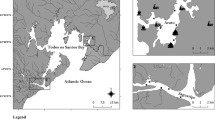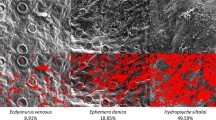Abstract
Aquatic macroinvertebrates were collected from five sites in the Neversink Reservoir Watershed in Sullivan County, New York: Aden Brook, Biscuit Brook, Main Branch, Tison and Winnisook, and examined for gill abnormalities. The Neversink Reservoir is part of the New York City water supply system and is located in the Catskill Mountains. Total mercury and methylmercury concentrations were measured by the New York State Department of Environmental Conservation (NYSDEC) in composite samples of macroinvertebrates at the five sites and ranged from 13.6 to 20.9 ng/g total mercury and 2.4–9.8 ng/g methylmercury. Gill deformities in the organisms were evident from each sampling site. These were observed as puckering or dimpling of the gill lamellae and interior spotting. The greatest percentage of gill morphological abnormalities were from invertebrates at the Main Branch site where 28% of invertebrate gills exhibited abnormalities. This site had the highest mercury/methylmercury concentration in composite invertebrate samples. Macroinvertebrates from a reference location showed little evidence of gill abnormalities. Other factors may have contributed to the abnormalities such as dissolved oxygen, pH, temperature, other contaminants, and/or stream profiles.



Similar content being viewed by others
References
Block M, Part P, Glynn AW (1997) Influence of water quality on the accumulation of methyl203 mercury on gill tissue of minnow (Phoxinus phoxinus). Comp Biochem Physiol 118C(2):191–197
Bode RW, Novak MA, Abele LE, Heitzman DL, Smith AJ (2002) Quality assurance work plan for biological stream monitoring in New York State. New York State Department of Environmental Conservation, Albany, NY
Boening D W, (2000) Ecological effects, transport, and fate of mercury: a general review. Chemosphere 40:1335–1351
Braeckamn B, Cornelis R, Rezeznik U, Raes H (1998) Uptake of HgCl2 and MeHgCl in an insect cell line (Aedes albopictus C6/36). Environ Res (Section A) 79:33–40
EPA 2001. Water quality criterion for the protection of human health: methylmercury. EPA-823-R-01–001. Office of Science and Technology and Office of Water, Washington, D.C
Fivelstad S, Waugbo R, Zeitz S, Hosfeld ACD, Olsen AB, Stefansson S (2003) A major water quality problem in smolt farms: combined effects of carbon dioxide reduced pH and aluminum on atlantic salmon (Salmo salar L.) smots: physiology and growth. Aquaculture 339–357
Hall BD, Roseberg DM, Wiens AP (1998) Methylmercury in aquatic insects from an experimental reservoir. Can J Fish Aquat Sci 55(9):2036–2047
Jeremiason JD, Engstrom DR Swain EB, Nater EA, Johnson BM, Almendinger JE, Monson BA, Kolka RK (2006) Sulfate addition increases methylmercury production in an experimental wetland. Environ Sci Technol 40(12):3800–3806
Kanost MR (2003) Hemolymph. In: Resh VH, Carde RT (eds) Encyclopedia of Insects. Academic Press, New York, NY, pp 505–508
Laporte JM, Andes A, Mason RP (2002) Effects of ligands and other metals on the uptake of mercury and methylmercury across the gills and the intestine of the blue crab (Callinectes sapidus). Comp Biochem Physiol(Part C) 131:185–196
Lawrence GB, Burns DA, Baldigo BP, Murdoch PS, Lovett GM (2001) Controls of stream chemistry and fish populations in the Neversink Watershed, Catskill Mountains, New York. Dept. of Interior, U.S. Geological Survey, WRIR 00–4040
Lechleitrer RA, Cherry DS, Cairns J Jr, Stetler DA (1985) Ionoregulatory and toxicological responses of stonefly nymphs (Plecoptera) to acidic and alkaline pH. Arch Environ Contam Toxicol 14:179–185
Loukmas JJ, Quinn SO, Bloomfield J (2006) Total and methylmercury in the Neversink Reservoir watershed. New York State Department of Environmental Conservation Technical Report, Manuscript in progress
Loukmas JJ, Skinner LC, (2005) Mercury and organic chemicals in fish from the New York City Reservoir system. Division of Fish, Wildlife, and Marine Resources, Bureau of Habitat Technical Report, New York State Department of Environmental Conservation, Albany, NY, pp 144
Miller EK, Vanarsdale GJ, Keeler A, Chalmers L, Poissant NC, Kamman NC, Brulotte R (2005) Estimation and mapping of wet and dry mercury deposition across northeastern North America. Ecotoxicology 14:53–70
NYSDEC–Statewide Waters Monitoring Section (2003) Method 245.1
NYSDOH (2004) Chemicals in sportfish and game: health advisories 2004–2005. New York State Department of Health, Troy, NY
Peckarsky BL, Fraissinet PR, Penton MA, Conlkin DJ Jr (1990) Freshwater Macroinvertebrates of Northeastern North America. Cornell, Ithaca
Pennuto CM, Lane OP, Evers DC, Taylor RJ, Loukmas J (2005) Mercury in the northern crayfish Orconectes virilis (Hagen) in New England, USA. Ecotoxicology 14:149–162
Ribeiro CA, Oliveria PE, Pfeiffer WC, Rouleau C (2000) Comparative uptake, bioaccumulation and gill damages of inorganic Hg in tropical and Nordic freshwater fish. Environ Res (Section A) 83:286–292
Simonin HA, Meyer MW (1998) Mercury and other air toxics in the Adirondack region of New York. Environ Sci Policy 1:199–209
Simpson KW (1980) Abnormalities in the tracheal gills of aquatic insects collected from streams receiving chlorinated or crude oil wastes. Freshwater Biol 10:581–583
Trembly A, Cloutier L, Lucotte M (1998) Total mercury and methylmercury fluxes via emerging insects in recently flooded hydroelectric reservoirs and a natural lake. Sci Total Environ 219:209–221
USEPA (2001) Method 1630. Methylmercury in water by distillation, aqueous ethylation, purge and trap and CVAFS. EPA-821-R-01–020 Office of Water, US Environmental Protection Agency, Washington, D.C
USEPA (2001) Appendix to Method 1631 (1631A). Total mercury in tissue, sludge, sediment and soil by acid digestion and BrCl oxidation. EPA-821-R-01–013. Office of Water, US Environmental Protection Agency, Washington, D.C
Watras CJ, Back RC, Halvorsen S, Hudson RJM, Morrison KA, Wente SP (1998) Bioaccumulation of mercury in pelagic freshwater food webs. Sci Total Environ 219:183–208
Acknowledgements
This investigation would not have been possible without the field study investigation performed in conjunction with Jefferey Loukmas from the New York State Department of Environmental Conservation (NYSDEC). We also thank Robert Bode, Margaret Novak, Diana Heitzman, Larry Abele and Alexander Smith (NYSDEC) for their helpful discussions and for use of their laboratory facilities. Sincere thanks to Nick Skinner, Larry Skinner and Nicole Wright for their technical assistance.
Author information
Authors and Affiliations
Corresponding author
Rights and permissions
About this article
Cite this article
Skinner, K.M., Bennett, J.D. Altered gill morphology in benthic macroinvertebrates from mercury enriched streams in the Neversink Reservoir Watershed, New York. Ecotoxicology 16, 311–316 (2007). https://doi.org/10.1007/s10646-006-0130-0
Received:
Accepted:
Published:
Issue Date:
DOI: https://doi.org/10.1007/s10646-006-0130-0




